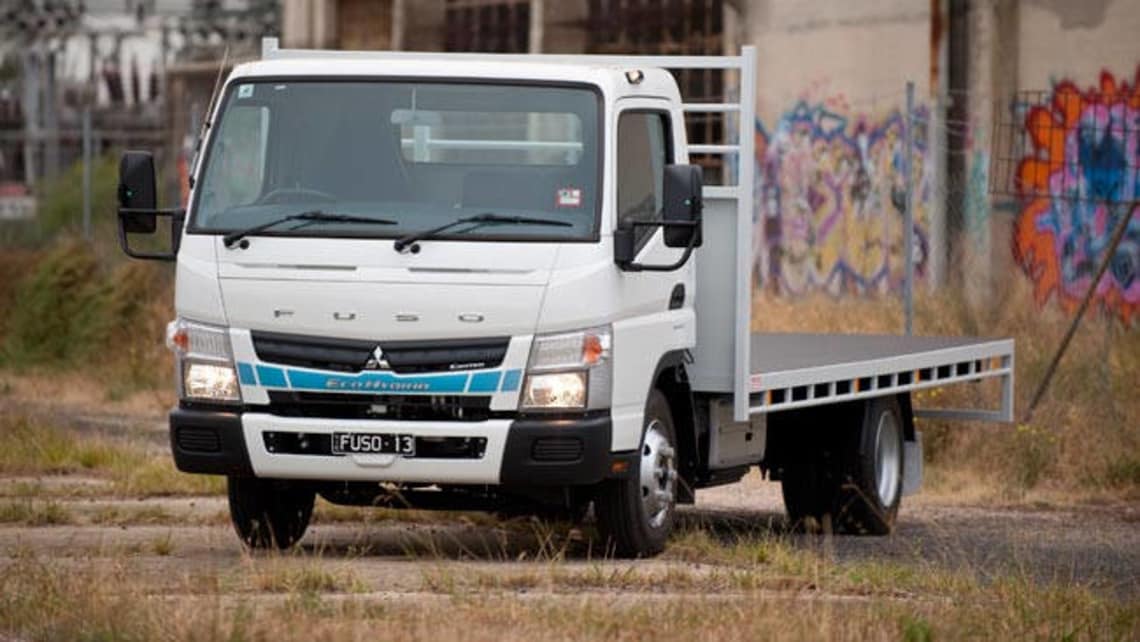
Mitsubishi Fuso 2013 Review

Hybrid trucks must be affordable to be taken seriously. Mitsubishi Fuso obviously had this in mind when it developed the second-generation hybrid Eco Canter.
It’s not perfect, but it does offer significant savings at a much more realistic price. To the first Eco Canter hybrid, you had to pay a 40 per cent premium over the standard truck. This time, the premium is just 14 per cent.
The first model was really only bought by those who wanted to project a green image and were happy to wear the extra cost. This time around operators running in certain conditions can argue that buying one makes both financial and environmental sense.
TECHNOLOGY
The green Canter runs the same 110kW/370Nm 3.0-litre four-cylinder turbo diesel as the regular model, but the hybrid also has an electric motor in between the engine and the transmission that contributes 40kW and 220Nm.
The electric motor can lend a hand under acceleration and is even able to provide all the power the truck needs at low speeds, although the diesel still needs to tick over in order to provide assistance to the steering and other systems.
Like car hybrids, the Eco Canter collects energy when it decelerates and sends it to a battery pack. Fuso has stuck with advanced lithium ion batteries, but the new cell design means they run cooler.
The fuel economy savings of the hybrid system very much depend on the way the truck is being used. Fuso says that in stop-start conditions, the Eco Canter could use up to 25 per cent less than the regular model.
DRIVING
We drove the Canter in country and city conditions, running along the Great Ocean Road from Lorne to the centre of Geelong. It was too short a run to get a fuel reading, but it gave a good idea of what living with an Eco Canter would be like. The overall impression was that this is a good truck that could be better.
Fuso decided to use the dual-clutch automated manual transmission, which is a fantastic gearbox when used with the regular Canter.
It doesn’t work so well in the Eco Canter and our test truck changed gears in the strangest of places. Even after a software re-flash, the automatic still wasn’t as good as the last generation single clutch automated manual and that wasn’t a great transmission.
It’s not clear whether the more complex dual clutch transmission is too complicated to work well with the electric motor or whether it is a matter of calibration.
The Eco Canter certainly has ample performance. The acceleration is excellent and it works well enough at higher speeds too. If you feather the throttle, it is possible to use only the electric motor for momentum, but the diesel kicks if you accelerate briskly. The electric motor appears noisier than the last and there is quite an audible electric whirr as it builds up speed.
The diesel engine cuts off when you pull up at an intersection to save fuel. As soon as you lift your foot off the brake, the engine cranks up again and away you go.
Last time around the electric motor was used to crank the engine and it started extremely quickly. This time around, the regular starter motor is used and it takes longer.
If you are the first person to move away from a set of lights, this is a problem and you will hold people up. If you are second or further from the lights and get a little anticipation time, it won’t be an issue. Fuso should look to sort the gearbox out, but the other issues are not major.
The second generation Eco Canter is not quite as easy to live with as normal Canter, but it is super efficient and, for the first time, affordable. That alone means it’s worthy of a test drive.






